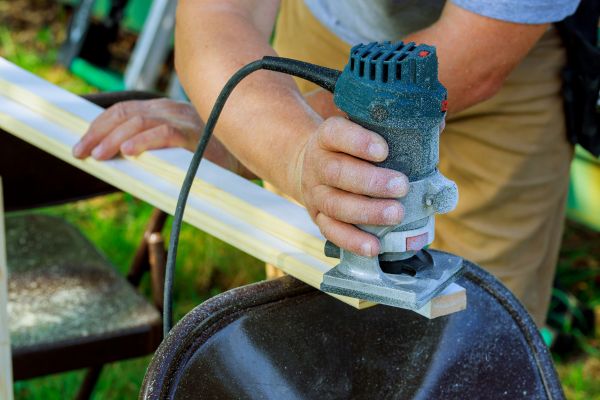Should I Be Using A Palm, Plunge Or Fixed Base Router?
In the world of woodworking, mastering the art of routing is a pivotal skill that can elevate the precision and intricacy of your projects. Routing, a technique central to shaping, trimming, and detailing wood surfaces, plays a crucial role in bringing artistic visions to fruition. Whether crafting bespoke furniture or custom cabinetry, choosing the right router—be it a palm router for intricate detailing, a plunge router for versatile applications, or a fixed base router for stability—becomes a crucial decision that directly impacts the quality and efficiency of your creations. In this guide, we explore the distinctions between these router types and highlight the significance of routing in enhancing both the aesthetics and functionality of your woodworking projects.

Router Types
- Palm Router
- Small lightweight and compact in design, this handheld tool is perfect for precise, intricate designs and small scale projects. Offering ease of maneuverability and control with one-handed operation, it excels in applications that demand attention to detail.
- Plunge Router
- Plunge routers feature a spring-loaded base, allowing the router bit to be plunged into the material. This design provides versatility, making plunge routers suitable for tasks like mortising, dadoing and plunge cuts. It is able to make depth adjustments during operation, offering flexibility in woodworking projects.
- Fixed Base Router
- A fixed-base router is larger and typically mounted to a router table or used with both hands for increased stability. It’s suitable for edge profiling, dadoing and router table tasks.
Project Requirements

Precision and Detail
If your project involves intricate detailing, such as edge trimming or small-scale decorative edge designs, a palm router may be the ideal choice. Its compact size and one-handed operation make it perfect for tasks that demand precision and control.
Versatility and Depth
For versatile applications requiring plunge cuts, dadoes, and adjustable depths, a plunge router is well-suited. Its ability to plunge into the material and make depth adjustments during operation adds a layer of flexibility, making it a go-to tool for various tasks.
Stability and Consistency
When stability and consistent depth are paramount, especially for tasks like dadoing or router table applications, a fixed base router might be the best fit. Its stationary design and ease of use make it a solid choice for projects that demand accuracy.
Workspace Considerations

Portability
If you value portability and need a router that can be easily maneuvered, a palm router is the most suitable. Its lightweight design and compact size make it convenient for users who may need to move around frequently.
Stationary Applications
A fixed base router is preferrable for tasks that involve stationary applications or the use of a router table. Its stability and ease of mounting make it a reliable choice for projects that don’t require constant movement.
Versatility in Movement
A plunge router strikes a balance between portability and stability. While it may be bulkier than a palm router, its ability to handle both handheld and stationary applications makes it a versatile option.
Skill Level
Beginner Friendly
If you are new to woodworking and looking for a user-friendly option, a fixed base router might be the best starting point. Its simplicity and stability make it easier for beginners to grasp the basics of routing.
Intermediate to Advanced
Woodworkers with more experience or those tackling complex projects may find the versatility of a plunge router to be a valuable asset. However, mastering its plunge mechanism and depth adjustments may require some practice.
Intricate Detailing
For users comfortable with handling smaller tools and seeking precision in intricate detailing, a palm router is a suitable choice. Its size and maneuverability cater to those who prioritize control in their woodworking tasks.

Ultimately, the decision between a palm, plunge, or fixed base router hinges on the specific requirements of your woodworking projects. Consider the intricacy of your tasks, the level of precision needed, your workspace dynamics, and your skill level.
- The Best Solvol Alternative: Gritmitts
Looking for the best Solvol alternative? Try the Australian made Gritmitts pumice soap bar to clean ...
- All About Sanding Belts - Which One Is Best For Your Job?
Precision and efficiency are paramount in construction and engineering. Whether smoothing rough edge...
- 3M Cubitron 3 - Produce More With Less!
Discover the all new 3M Cubitron 3 performance abrasives at BST Group. Shop grinding wheels, cut off...



